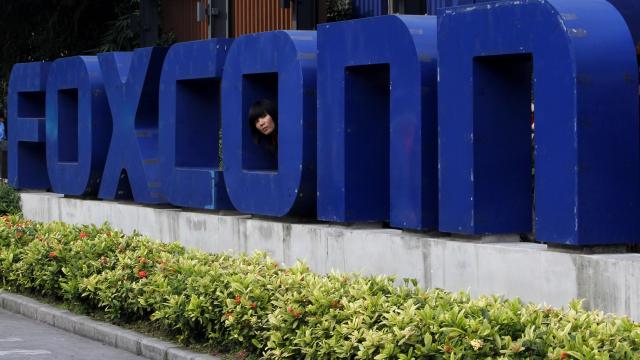Reports from The Wall Street Journal and the Nikkei Asian Review indicate that Foxconn, the manufacturer that assembles iPhones for Apple, is considering building a $US7 billion ($9 billion) display factory in the United States.
Image: AP
That could mean that one of Apple’s biggest partners would have a factory assembling components in the United States. According to Nikkei Asian Review, Foxconn’s chairman Terry Gou told reporters on Sunday that Apple is considering investing in a potential US factory with them “because they need the [panels] as well”.
Foxconn has been considering building a display factory in the US for years, citing the expense of shipping large-screen TVs from Asia to the United States, but if this factory does happen, it could have much bigger implications. Donald Trump has vowed to bring manufacturing back to the United States, and the display factory, which could create 30,000 to 50,000 jobs, would undoubtedly be a big coup for America’s new Commander in Chief.
But don’t get too excited. A US-based display factory does not mean that iPhone’s would actually be made in the United States. Moreover, as The Journal notes, Gou and his company would require plenty of concessions to even bring the factory to the United States to begin with:
Any deal would hinge on getting land and power at bargain rates, Mr. Gou said.
“If U.S. state governments are willing to provide these terms, and we calculate and it is cheaper than shipping from China or Japan, then why wouldn’t Sharp build a factory in the U.S.,” he said.
Donald Trump has made a lot of statements about giving incentives for companies to bring manufacturing back to the US, but most of that is in the way of tax cuts. A company like Foxconn will need more than just tax breaks to make it economically feasible for it to move production of any component stateside.
Last month, the New York Times produced an in-depth report on Zhengzhou, China — known by locals as iPhone City — and the massive iPhone factory Foxconn has built in that city with the help of the Chinese government. The benefits that the Chinese government give to Foxconn (and in turn, Apple), go way beyond tax breaks. The Chinese government financed construction on the factory, housing for workers, offered discounts on power, eliminated corporate taxes and are even involved in training and recruiting employees.
In other words, China has made it very attractive for Foxconn to make it its primary facility factory.
According to the Nikkei Asian Review, Gou said that even if it did built a factory in the United States, China would still be Foxconn’s primary manufacturing base for Apple and its other vendors. “Foxconn will not leave. Foxconn will stay [in China],” Gou told reporters.
In the case of Foxconn, the large screens it makes for its Sharp division might end up being cheaper if made in the US, again, to save on shipping. But given how many components are sourced and designed to be sent to China for assembly, it seems unlikely that iPhone production could ever arrive in the United States.
Even if it could, Foxconn makes something like 100 million iPhones a year in China. It would be impossible for Apple to make phones in that sort of volume in the United States. So even if an iPhone was assembled in the US, most phones would still be made in China for the foreseeable future.
That said, there are certain circumstances where US-based assembly could make sense. As Apple’s sales in China have slowed, the financial benefits of making phones in that country drop, when you add in import taxes and shipping costs to other regions. And Apple has made products in the United States before. Most recently, Mac Pro assembly was brought to the United States. For years, certain iMac units have been assembled in the USA too (though most are made and assembled in China).
Apple has also previously worked with its suppliers on building factories in the US. Back in 2013, Apple co-invested in a billion dollar sapphire glass factory in Arizona in partnership with a company called GT Advanced Technologies. That partnership ended poorly, with GT Advanced filing for bankruptcy after it was unable to produce glass screens to Apple’s standards. Apple got its money back and is now looking at repurposing the factory as a place to make data centre cabinets.
That said, it’s important to note that Tim Cook, Apple’s CEO, has always been very focused on the supply chain. In fact, when he was hired by Steve Jobs to join Apple in 1997, one of his major accomplishments was moving Apple from manufacturing and assembling its computers and products in the US, to outsourcing production to companies such as Foxconn.
Apple didn’t become the world’s richest company by making deals that don’t benefit itself first and foremost. Look at how the company is playing hardball with the Indian government to bring phone assembly to that country to get an idea as to just how deep concessions would have to be for any production to arrive in the US. If Donald Trump is serious about bringing iPhone manufacturing to the US, he better be able to pay up.
